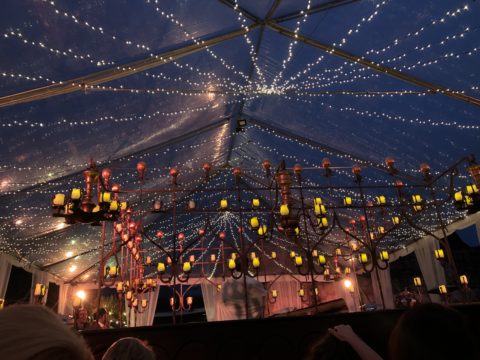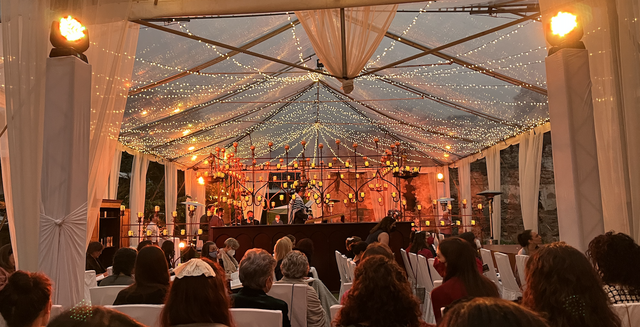On a Friday evening in Antigua, Guatemala, a swarm of guests from all over the world steps into an outdoor hotel plaza for a lively Kabbalat Shabbat service. We have gathered to kick off a long wedding weekend and, as the sun begins to set over the volcanoes that surround the city, the groom leads us all in song as his family beams with pride. We are seated in a space that has been transformed into a re-creation of the Altneuschul of Prague, where the bride’s grandfather once prayed every Shabbat. The bima is a perfect replica, and the space drips in candlelight cast by the lanterns that adorn it. Our voices rise as we sing; we are awed by the splendor of our setting, of the arrival of the Sabbath, and of our important job to surround this couple with joy.
It feels poignant and full of purpose.
It also feels rather chilly. As the sky gets darker, I regret not bringing a sweater or shawl until, not a moment later, a fellow guest hands me a plush blanket in which to wrap myself. Our hosts have brought out dozens of these blankets to meet this exact need, anticipating that many of us may be caught by surprise by the swift drop in temperature. I fold myself in the soft fabric and let the evening transport me.
When I debrief this moment with the bride a few weeks later, remarking at the sheer beauty of that Erev Shabbat, as well as the uncanny timing of the blankets, she smiles and shrugs. “It was my mom’s vision,” she says, with appreciation, “and she knows how to bring a dream to life.”
Dreaming, of course, is the root of imagination. When we allow ourselves, we can glimpse a vision of what’s possible, enabling us to build toward that vision with care and intentionality. Over the last many years, I have trained hundreds of rabbis and Jewish educators to strengthen this imaginative muscle as they build communities of Jewish learning, most recently through my latest project IYUN, which builds cohorts of adults who explore existential questions through the lens of Torah.
In preparing educators to build these learning communities, we work to awaken their imagination by helping them reflect on the total moral, aesthetic, social, emotional, and spiritual experience of their community members. In exercising this type of imagination, we help teachers of Torah understand that a bifurcation between content (what we teach) and pedagogy (how we teach it) does not exist; rather, there is a holistic experience where tone, visual aesthetics, language, colors, words, ideas, and texts are all components. The educator then consciously reflects on the kind of experience she wishes to build and implements her components artfully to yield this effect. Much like the bride’s mother at the Guatemalan wedding, we can imagine not only what we will read and what we will say, but also how people will move through our space and how they will feel.
 Over the years, I’ve found creative ways to sensitize educators to this type of empathic imagination. I’ve guided them on tours through a campus library, the local Apple store, an Equinox gym, or the community mikvah, all in service of reflecting on the experience of those who pass through. Some notice that you can’t reach the back wall of an Apple store without a friendly employee approaching you to offer personalized support. Others notice that the fresh towels at Equinox smell like eucalyptus, or that there are multiple locks on the doors at the mikvah to protect privacy. Still others pick up on the amount of space to maneuver between stacks at the library. Once we start looking at ‘user experience’ in this way, it’s hard to unsee it. This kind of imagination will begin to show up in the choices we make in our community spaces as well. We may arrange our chairs in a new way, dim the fluorescent lighting in favor of lamplight, frame discussion questions more intentionally, or pace our teaching differently.
Over the years, I’ve found creative ways to sensitize educators to this type of empathic imagination. I’ve guided them on tours through a campus library, the local Apple store, an Equinox gym, or the community mikvah, all in service of reflecting on the experience of those who pass through. Some notice that you can’t reach the back wall of an Apple store without a friendly employee approaching you to offer personalized support. Others notice that the fresh towels at Equinox smell like eucalyptus, or that there are multiple locks on the doors at the mikvah to protect privacy. Still others pick up on the amount of space to maneuver between stacks at the library. Once we start looking at ‘user experience’ in this way, it’s hard to unsee it. This kind of imagination will begin to show up in the choices we make in our community spaces as well. We may arrange our chairs in a new way, dim the fluorescent lighting in favor of lamplight, frame discussion questions more intentionally, or pace our teaching differently.
In IYUN, we build facilitator’s materials that consider this type of empathic imagination. We script every moment of the experience, from the moment learners enter the room (real or virtual) to the moment they leave. We build in creative re-description (nibbles are never “snacks” but tapas), transform the interior design, consider food, atmospheres, and smells, plan playlists, adjust for multiple learning styles, and build into the learning opportunities to catalyze friendships. And, most importantly, we prime educators to use their imagination along with us – what will their unique learners need on this unique day?
In this way, imagination is not only about creative thinking or about forming grand, novel ideas. Rather, it is about seeing our way into someone else’s future reality and exercising our empathy and resourcefulness to build that reality. We may not always seek to create settings that are comfortable – sometimes we wish to agitate or provoke or push. Whatever our aims, we can work to see the future world through the eyes of our community members, and intentionally build that world with and for them.
None of this is expensive or difficult to do (just as it is not an exorbitant expense or a logistical hurdle to purchase a couple dozen blankets for a wedding weekend), but these instances of choice and curation indicate to participants that their needs have been taken into account. That they are cared for, seen, and understood. And, far from cheapening the ideas and content we may share in our communal spaces, we elevate them, raising the bar from “just” Kabbalat Shabbat in the Antigua night air to a wholly immersive experience we might sink into fully.

Photos provided by the author.
Get To Know The Author
WFF Erica Frankel (Class 3) is the Executive Director of OOI, an innovation laboratory which launches, catalyzes, and scales new projects to advance Jewish life. She is also the founder of IYUN and Kehillat Harlem, and the Senior Educator at Based in Harlem.

